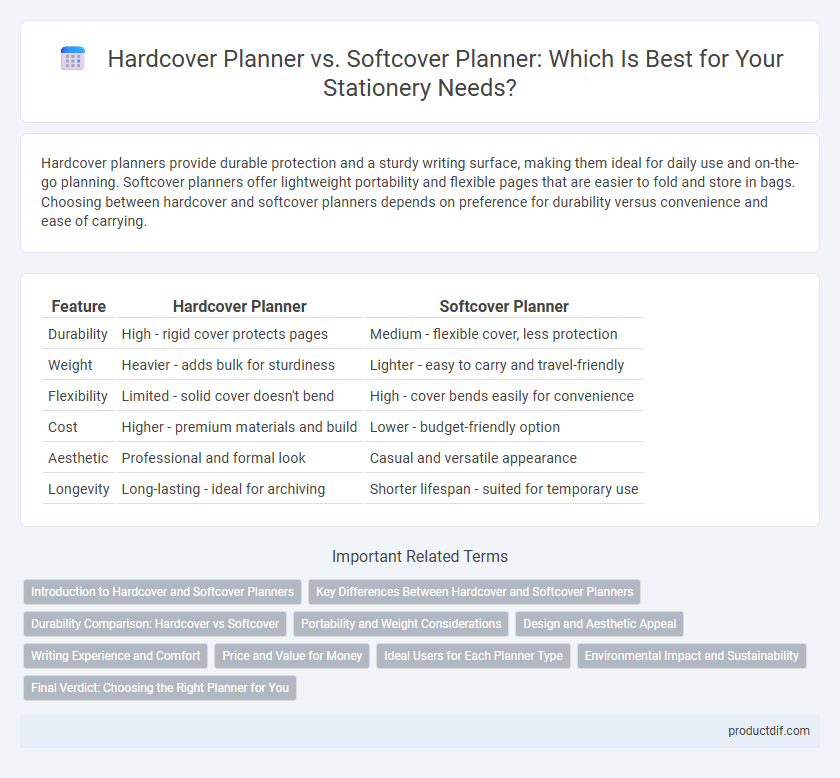Hardcover planners provide durable protection and a sturdy writing surface, making them ideal for daily use and on-the-go planning. Softcover planners offer lightweight portability and flexible pages that are easier to fold and store in bags. Choosing between hardcover and softcover planners depends on preference for durability versus convenience and ease of carrying.
Table of Comparison
| Feature | Hardcover Planner | Softcover Planner |
|---|---|---|
| Durability | High - rigid cover protects pages | Medium - flexible cover, less protection |
| Weight | Heavier - adds bulk for sturdiness | Lighter - easy to carry and travel-friendly |
| Flexibility | Limited - solid cover doesn't bend | High - cover bends easily for convenience |
| Cost | Higher - premium materials and build | Lower - budget-friendly option |
| Aesthetic | Professional and formal look | Casual and versatile appearance |
| Longevity | Long-lasting - ideal for archiving | Shorter lifespan - suited for temporary use |
Introduction to Hardcover and Softcover Planners
Hardcover planners feature rigid, durable covers that provide robust protection and a premium feel, enhancing long-term usability and professional appearance. Softcover planners offer flexible, lightweight covers that prioritize portability and ease of use, making them ideal for everyday carry and casual note-taking. Both options cater to distinct preferences in durability, style, and functionality within the stationery market.
Key Differences Between Hardcover and Softcover Planners
Hardcover planners offer enhanced durability and protection, making them ideal for long-term use and frequent handling, while softcover planners provide lightweight flexibility and easier portability. The rigid cover of hardcover planners ensures pages remain intact and unbent, enhancing longevity, whereas softcover planners typically feature a more flexible binding that allows for easier storage in bags. Hardcover planners often have a premium feel and sturdier construction, whereas softcover versions generally cost less and come in a variety of flexible designs.
Durability Comparison: Hardcover vs Softcover
Hardcover planners offer superior durability due to their rigid covers, which protect pages from bending, spills, and daily wear, making them ideal for long-term use. Softcover planners are more flexible and lightweight but tend to show signs of wear quicker, such as creasing and edge damage. For users prioritizing longevity and protection, hardcover planners are a more resilient choice compared to softcover options.
Portability and Weight Considerations
Hardcover planners offer superior protection for pages but tend to be heavier and less portable, making them less ideal for carrying in small bags. Softcover planners provide lightweight and flexible options, enhancing portability for daily use and on-the-go scheduling. Choosing between the two depends on balancing the need for durability versus convenience in mobility.
Design and Aesthetic Appeal
Hardcover planners offer a sturdy, premium design that often features embossed details, vibrant colors, and a polished finish, making them visually striking and durable for everyday use. Softcover planners provide a flexible, lightweight aesthetic with matte or textured covers that appeal to those seeking a casual, minimalist look and ease of portability. The choice between hardcover and softcover planners depends on personal style preferences and the desired balance between durability and comfort.
Writing Experience and Comfort
Hardcover planners provide a firm and stable writing surface, enhancing precision and control, especially when writing on the go, while softcover planners offer flexibility and a lightweight feel that adapts comfortably to different hand positions. The rigid structure of hardcover planners prevents pages from bending or slipping, contributing to a neater writing experience, whereas the supple cover of softcover planners reduces hand fatigue during extended use. Choice between hardcover and softcover planners ultimately depends on the preferred balance between writing stability and portable comfort for everyday note-taking and scheduling.
Price and Value for Money
Hardcover planners typically cost more due to their durable materials and long-lasting build, offering enhanced protection for daily use. Softcover planners are more affordable, providing flexibility and lightweight convenience but may compromise on durability over time. Evaluating price against value for money depends on whether long-term resilience or budget-friendly portability is the priority for the user.
Ideal Users for Each Planner Type
Hardcover planners are ideal for professionals and students who require durability and protection for frequent daily use, offering structured support for organized note-taking and scheduling. Softcover planners suit creative individuals and casual users who prefer lightweight, flexible options for easy portability and personalized customization. Each type caters to specific needs by balancing robustness and convenience based on user lifestyle and planner usage intensity.
Environmental Impact and Sustainability
Hardcover planners often use more materials such as cardboard and synthetic lamination, resulting in a higher carbon footprint compared to softcover planners, which typically utilize lighter, recyclable paper and less adhesive. Softcover planners are more easily biodegradable and often incorporate recycled paper, making them a preferable choice for reducing landfill waste and promoting sustainability. Choosing planners manufactured with FSC-certified paper and soy-based inks further minimizes environmental impact across both hardcover and softcover options.
Final Verdict: Choosing the Right Planner for You
Hardcover planners offer durability and a professional look ideal for daily use and long-term planning, while softcover planners provide lightweight flexibility and portability for on-the-go scheduling. Consider your lifestyle and preferences--choose a hardcover planner if you prioritize protection and structure, or a softcover planner if convenience and ease of carrying are more important. Selecting the right planner depends on balancing durability, portability, and your personal organizational needs.
Hardcover planner vs Softcover planner Infographic

 productdif.com
productdif.com